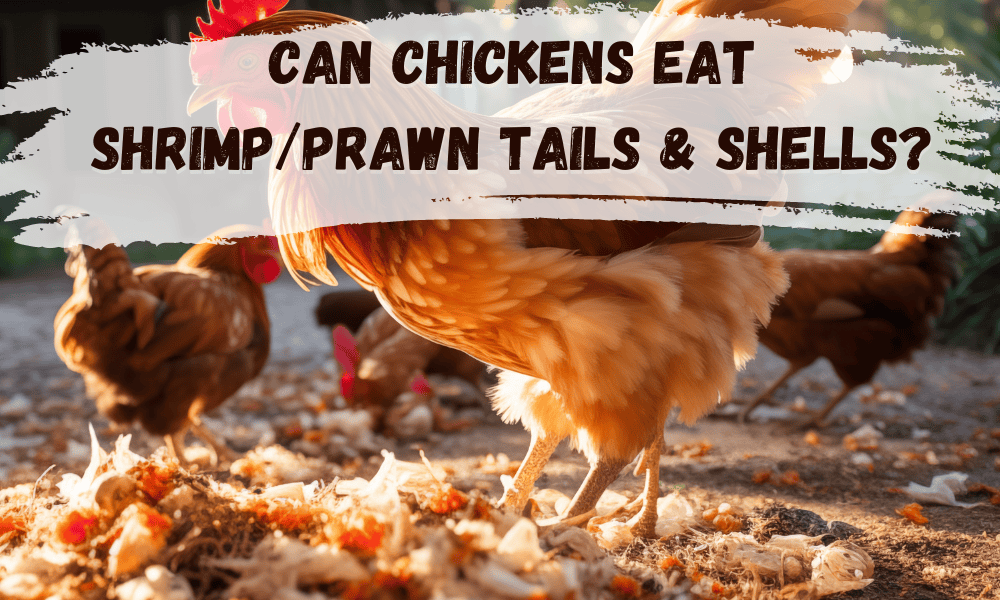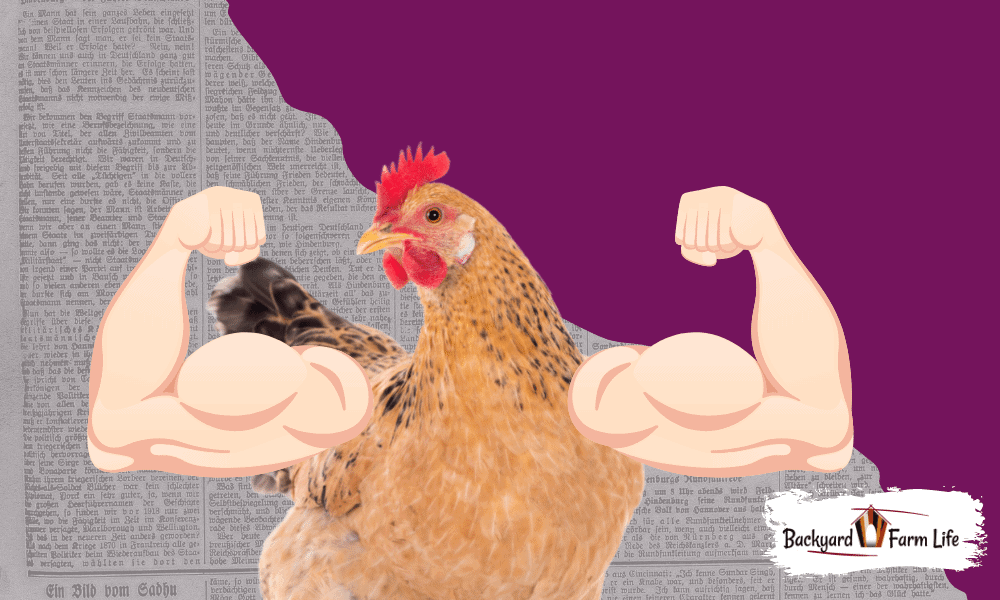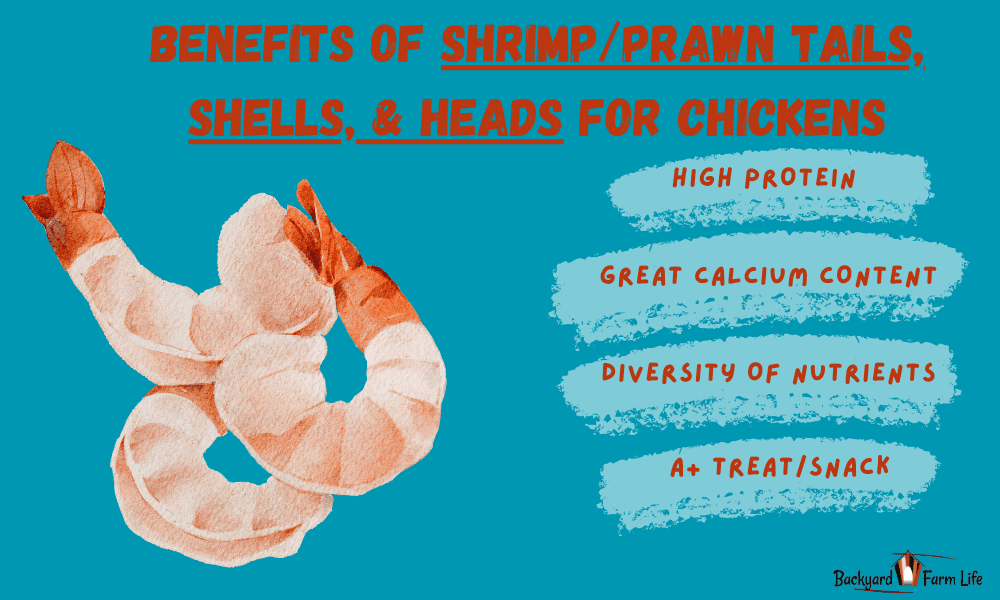So you’ve finished a feast of shrimp or prawns and the only evidence left is the shells, heads, and tails.
I guarantee you’ve been thinking “Hmm, I wonder if my chickens would like these scraps?”
Don’t worry – we’ve got you covered.
Here’s exactly why we don’t hesitate to feed our flock shrimp and prawn leftovers, including the shells, heads, and tails!
Contents
Can Chickens Eat Shrimp Tails & Shells?

It’s no secret chickens will eat just about anything you toss their way. But, that’s why it’s so important we only provide foods that are genuinely healthy and safe for our fluffy-butted friends.
The good news? Chickens CAN eat any part of shrimp or prawns, including their tails, heads, and shells, whether they’re cooked or raw.
You see, shrimp tails and shrimp shells (& prawns) are made almost entirely of protein and calcium.
Adult chickens need about 16% protein in their daily diet, plus plenty of calcium for bone health and to maintain healthy egg-shell production.
So not only CAN chickens eat all parts of the shrimp or prawn, but it’s got great nutritional value too.

It’s worth mentioning that some chicken owners do have concerns that the chitin content (what makes the shrimp shell tough) may be harmful to chickens.
But this is simply not true!
Studies have shown that chitin DOES have nutritional value and causes NO adverse effects in poultry!
Plus, we’ve never had a problem feeding shrimp tails, shells, and heads to our flock.
Piecing everything together: shrimp heads, shrimp tails, and shrimp shells are absolutely safe for chickens to eat and are actually considered a nutritious snack when fed in moderation.
Note: Some chicken farmers seem to think too much fish/crustaceans can cause chicken eggs to taste “fishy”. In our experience, feeding your flock shrimp and prawn heads, shells, and tails in normal moderate amounts is highly unlikely to impact the flavor of the eggs as suggested.
The Nutritional Benefits Of Shrimp/Prawn Tails & Shells For Chickens?

Just because humans give shrimp tails and shells a miss, doesn’t mean these leftovers don’t still have rich nutritional content remaining.
Still not convinced?
Shrimp tails are comparatively just as healthy as the rest of the shrimp.
Shrimp tails are made of dried proteins, chitin, and ash, whose main composition is calcium and other important minerals.
The main nutritional benefits of feeding shrimp or prawn tails, shells, or heads to your flock are:
- High Protein: Protein plays a crucial role in maintaining the health of your flock as it improves growth, immunity, egg production, and overall health (plus added protein helps during the molting season or in winter).
- Great Calcium Content: Calcium supports the circulatory system, nervous system, cardiac system, and digestive system. Not to mention it’s essential for the formation of hard eggshells – helping to avoid egg production issues like soft-shelled eggs, liquid eggs, etc.
- Diversity Of Nutrients: It’s always good to supplement your chicken’s diet with other healthy food alternatives (up to 10% of their daily diet). Shrimp has countless other beneficial nutrients for your chickens including Zinc, Iron, Fatty acids, and Amino acids.
Tip: Feeding your flock scrambled eggs, including the crushed eggshell, provides very similar benefits, being high in protein and calcium!
How To Serve Shrimp Tails To Your Chickens?
As we know, chickens aren’t fussy. But, this doesn’t mean we can’t make it easier for them to consume their table scraps and treats.
It’s not likely that raw shrimp tails will contain anything unhealthy or unsafe for your chickens, but giving them a quick wash never hurts.
If you don’t want to feed them to your flock whole, you can just crush up the raw shrimp shells and add them into any other mix of healthy snacks or their normal feed mix for added calcium!
When it comes to serving cooked shrimp tails to your chickens you should take care to remove any added spices or other ingredients which may be considered harmful to your chickens.
Boiled or steamed shrimp tails will be nice and soft for your chickens to eat, just remember to remove any of the following ingredients:
- Seasonings like salt, pepper, or spices.
- Garlic or garlic butter.
- Onion.
- Any excess fat or oil.
So Why Do We Always Feed Our Flock Shrimp/Prawn Shells?
Do I have to spell it out for you!?
Shrimp and prawn shells, tails, heads, or just the whole dang thing is safe for your chickens to eat in normal moderate amounts (like when you have leftovers, as a prime example).
It’s considered healthy in these treat-like quantities – providing plenty of extra protein, calcium, and other nutrients.
Plus let’s not hide the fact that your flock will absolutely go wild for it.
Remember, 90% of a chicken’s daily diet should consist of an optimized layer seed mix or pellets. But the other 10% can be supplemented with perfectly healthy snacks and treats – just like shrimp tails!
